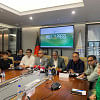Semiconductors can be the new RMG

With the consistent growth of our IT sector in recent years, Bangladesh's endeavour to become a knowledge-based economy has already gained significant momentum. While labour-centric sectors like the ready-made garment (RMG) industry remain a key driver in our economy, it is important now to expand the focus to skill-intensive sectors so that we can stay globally competitive and can create employment for the educated masses. The emerging semiconductor industry can play an instrumental role in this regard.
It may sound like an overstatement to say that the semiconductor industry has the potential to gain the same status as the RMG industry in the future. However, in view of the global and local prospects of this booming industry, we can definitely hope to witness such a scenario.
A lifeline for all electronic devices and systems, the global semiconductor industry is set to grow exponentially in the coming decade. According to Precedence Research, the market value of this industry stands at $664.2 billion at present, and is expected to rise to over $1.88 trillion by 2032, reflecting a remarkable compound annual growth rate (CAGR) of 12.28 percent.
Bangladesh currently earns around $5 million annually from the semiconductor industry, mostly by providing integrated circuit (IC) designing services, while high-end services such as fabrication, packaging, assembly, and testing remain untapped by local semiconductor companies. But our achievement is not negligible either. Virtually non-existent two decades ago, the nascent industry has gained traction rapidly in recent years. If the revenue has been able to reach $5 million over such a short period, we can definitely set our sights high and hope for the semiconductor industry to catch up with the RMG industry in the long run.
Most importantly, our demographic dividend is already a big advantage for this endeavour. A country with a 28 percent youth population, Bangladesh sees around 20,000 students graduate with computer engineering and electrical and electronic engineering (EEE) degrees every year.
Most importantly, our demographic dividend is already a big advantage for this endeavour. A country with a 28 percent youth population, Bangladesh sees around 20,000 students graduate with computer engineering and electrical and electronic engineering (EEE) degrees every year. If trained properly, they can provide the necessary fuel for the growth of semiconductor industry.
However, a series of challenges stand in our way of achieving this goal, the biggest being the massive investment required for its development. Like most tech-based sectors, the semiconductor industry is highly capital-intensive, making it extremely challenging for companies to expand operations without the government's support.
Considering the immense potential of this sector, many countries around the world have taken initiatives to grow their respective semiconductor bases. For instance, the Indian government launched a programme named Semicon to promote the production of semiconductors in the country, with an incentive of 76,000 crore rupees. In order to take our industry forward, the Bangladesh government should mull over similar steps for the days to come. It can also accelerate semiconductor expansion by initiating bilateral dialogues with experts such as Taiwan, South Korea, and Japan.
The lack of an adequately trained workforce is another key challenge for the country's semiconductor industry. Back in 2007, I started Ulkasemi in Bangladesh with only four engineers. Creating a pool of trained professionals in line with our gradual expansion was a Herculean task. The workforce problem mainly stems from the lack of hands-on experience of our engineering students. Their academic knowledge of semiconductors is not sufficient to meet the professional requirements in the industry. Therefore, rigorous training is necessary to turn them into competent professionals.
The most effective way to overcome this challenge is to strengthen government-academia-industry collaboration. By engaging with academia, semiconductor experts can encourage students to take an interest in the field. It is equally important to include semiconductor-related topics such as advanced-level VLSI courses in the students' academic curriculum so that they can develop their knowledge of IC design, production, packaging and fabrication at an earlier stage.
The government recently declared its ambition to build a $10 billion semiconductor industry by 2031. If provided with the necessary support, Bangladesh's semiconductor industry could even surpass this target. The kind of support the RMG industry received during the 1980s-1990s, such as subsidies for electricity and gas supply, can lend impetus to our industry.
Currently, over $40 billion in gross revenue is earned annually by Bangladesh's RMG industry. However, it requires five million workers to generate this revenue, whereas the semiconductor industry could earn the same amount by employing only around 100,000 engineers. It shows the tremendous potential Bangladesh has in this thriving industry. It is high time we started shaping it as our gateway to a knowledge-based economy and a prospective alternative to the long-serving RMG industry.
Mohammed Enayetur Rahman is the founder, CEO, and president of ULKASEMI. He can be reached at [email protected].
Views expressed in this article are the author's own.
Follow The Daily Star Opinion on Facebook for the latest opinions, commentaries and analyses by experts and professionals. To contribute your article or letter to The Daily Star Opinion, see our guidelines for submission.

 For all latest news, follow The Daily Star's Google News channel.
For all latest news, follow The Daily Star's Google News channel. 











Comments